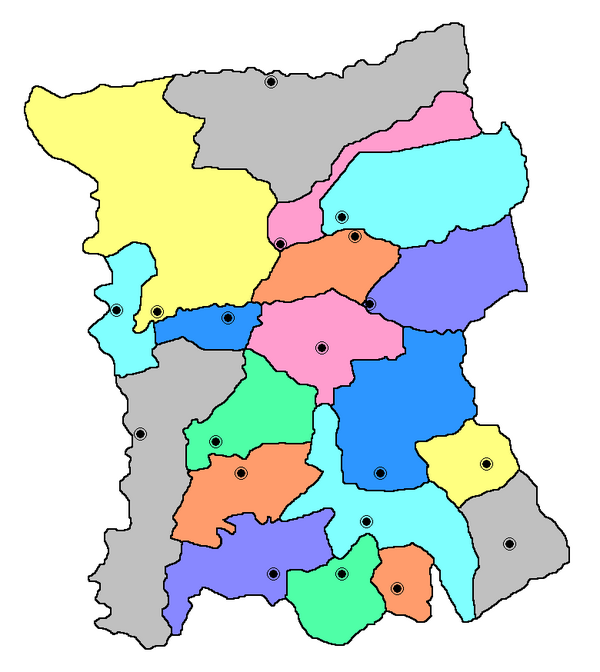San Pedro Department, Paraguay
The San Pedro department (Spanish: Departamento de San Pedro) is a department of Paraguay. The capital is the city of San Pedro de Ycuamandiyú. Its ISO 3166-2 code is PY-02.
|
Departamento de San Pedro | |
|---|---|
 | |
 Location of San Pedro, in red, in Paraguay | |
| Coordinates: 24°06′S 57°05′W / 24.100°S 57.083°WCoordinates: 24°06′S 57°05′W / 24.100°S 57.083°W | |
| Country | |
| Region | Oriental |
| Capital | San Pedro de Ycuamandiyú |
| Boroughs | 20 (See list) |
| Government | |
| • Governor | Vicente Rodríguez Arévalos[1] |
| Area | |
| • Total | 20,002 km2 (7,723 sq mi) |
| Population (2012)[2] | |
| • Total | 360,094 |
| • Density | 18.0029/km2 (46.6273/sq mi) |
| Time zone | UTC-04 (AST) |
| • Summer (DST) | UTC-03 (ADT) |
| ISO 3166 code | PY-02 |
| Website | Official website |
The name San Pedro ("Saint Peter") was given after its capital.
History
During the 17th and 18th centuries there was much problems with the people in the region. To help for the economic growth, three towns were started: San Estanislao (1749), Villa del Rosario (1786) and San Pedro de Ycuamandiyú (1786).[3]
San Pedro, the second department of the country, was created by law in 1906, and had the territories of Itacurubí del Rosario, Santa Rosa del Aguaray, Tacuatí, Unión, Ygatimi and Curuguaty, as well as the area of the present Canindeyú department. Its limits were given finally by the Law 426 of 26 December 1973.[3]
Geography
The San Pedro department is in the north central part of the Oriental region. It has an area of 20,002 km2 (7,723 sq mi), the largest of the Oriental region, with a population of 360,094 for a population density of 18.0.[2]
Limits
- To the north: Concepción and Amambay departments.
- To the east: Amambay and Canindeyú departments.
- To the south: Caaguazú and Cordillera departments.
- To the west: Presidente Hayes department, separated by the Paraguay river.
Rivers
The main river in the department, and of Paraguay, is the Paraguay that makes the western border of the department.
Other rivers are the Jejuí Guazú, 327 km (203 mi) long, and the Ypané, 323 km (201 mi) long.[3]
Climate
As of 2014[update], the total amount of precipitation in the city of San Pedro de Ycuamandiyú was 1,783.0 mm (70.2 in). The month with the most precipitation was April with 353.4 mm (13.9 in) of precipitation. The month with the least precipitation was August with 0 mm (0.0 in).[4]
The average temperature for the year 2014 in San Pedro de Ycuamandiyú was 23.7 °C (74.7 °F). The warmest month, on average, was February with an average temperature of 34.7 °C (94.5 °F). The coolest month on average is July, with an average temperature of 13.7 °C (56.7 °F).[4]
Districts
The department is divided in 20 districts:
| No. | Districts | Area[5] (km²) |
Population[6] (2015) |
Density |
|---|---|---|---|---|
| 1 | Antequera | 480 | 2,119 | 4.4 |
| 2 | Capiibary | 826 | 22,691 | 27.5 |
| 3 | Choré | 965 | 15,402 | 16.0 |
| 4 | General Elizardo Aquino | 816 | 12,773 | 15.7 |
| 5 | General Isidoro Resquín | 1,075 | 13,285 | 12.4 |
| 6 | Guayaibí | 1,460 | 15,859 | 10.9 |
| 7 | Itacurubí del Rosario | 769 | 6,137 | 8.0 |
| 8 | Liberación | 587 | 12,383 | 21.1 |
| 9 | Lima | 658 | 6,404 | 9.7 |
| 10 | Nueva Germania | 657 | 3,391 | 5.2 |
| 11 | San Estanislao | 1,700 | 27,203 | 16.0 |
| 12 | San Pablo | 320 | 2,016 | 6.3 |
| 13 | San Pedro de Ycuamandiyú | 3,176 | 17,896 | 5.6 |
| 14 | Santa Rosa del Aguaray | 1,572 | 19,415 | 12.4 |
| 15 | Tacuatí | 2,283 | 7,900 | 3.5 |
| 16 | Unión | 587 | 3,780 | 6.4 |
| 17 | Veinticinco de Diciembre | 995 | 5,414 | 5.4 |
| 18 | Villa del Rosario | 1,975 | 5,734 | 2.9 |
| 19 | Yataity del Norte | 316 | 6,753 | 21.4 |
| 20 | Yrybucuá | 509 | 7,873 | 15.5 |
San Pedro Department, Paraguay Media
A cart in Veinticinco de Diciembre San Pedro department
Related pages
References
- ↑ "El Gobernador" (in español). Gobernación de San Pedro. Retrieved 1 September 2016.
- ↑ 2.0 2.1 2.2 "Proyección Densidad Tasa 2012" (PDF) (in español). Dirección General de Estadísticas, Encuestas y Censos. Retrieved 1 September 2016.
- ↑ 3.0 3.1 3.2 "Plan de Desarrollo Departamental 2013/1018" (PDF) (in español). Gobernación de San Pedro. pp. 19–29. Archived from the original (PDF) on 30 March 2016. Retrieved 1 September 2016.
- ↑ 4.0 4.1 "Compendio Estadístico Ambiental del Paraguay 2014" (PDF) (in español). Dirección General de Estadísticas, Encuestas y Censos. January 2016. Retrieved 2 September 2016.
- ↑ "Territorio y Población" (zip) (in español). ADEPO - Asociación Paraguaya de Estudios de Población. 2015. Retrieved 2 September 2016.
- ↑ "Proyección de la población por sexo y edad, según distrito. Revisión 2015 (8.3 MB)" (PDF) (in español). DGEEC. 2015. Retrieved 2 September 2016.
Other websites
| Wikimedia Commons has media related to Lua error in Module:Commons_link at line 62: attempt to index field 'wikibase' (a nil value).. |
- Gobernación de San Pedro website (in Spanish)
- Statoids - Departments of Paraguay




